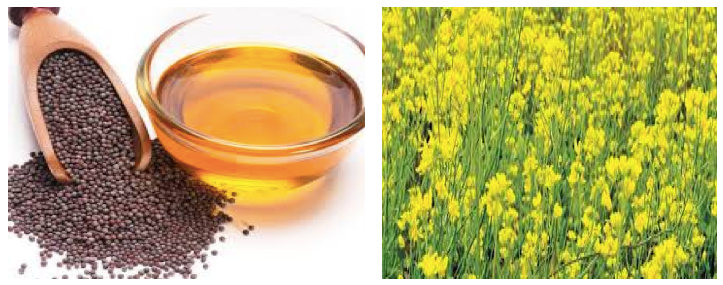[Originally published as part of my Column “Green Cardamoms “ in Shillong Times, Canvas, page 3].
Cutting the Mustard!
Author: Gaurangi Maitra

photo credits: www.indiamart.com & www.thehindubusinessline.com
Memory tags: The Mustard in all its avatars
One of the biggest epicurean tragedies is to have to eat elish bhapa or hilsa steamed in mustard sauce. without using ones fingers and at top speed, between two sessions of meetings of professed import! Apart from the very special taste of the fish ,the ground mustard seed paste adds a firery under undercurrent that tickles the tongue and the senses. Mustard, the yellow peril, has been long tamed for human delight. Its common English name “mustard” owes its genesis to an early preparation by mixing unfermented or new grape juice, known as "must" to tame the burning (ardens) taste of ground mustard seeds to make "burning must”, hence "mustard". Thus the world famous Dijon mustard is said to have originated in when Jean Naigeon of Dijon substituted verjuice, the acidic "green" juice of not-quite-ripe grapes, for vinegar in the traditional mustard recipe.
Mustard was not a spice or condiment they had to come east to find. Its apparently found its way to the English table thanks to the Gauls (did Obelix put mustard on wild boar?) who in turn learnt it from the Romans. Of the forty varieties of mustard plants available, only three enjoy world wide popularity in culinary use. The very pungent black seed variety probably originated Asia Minor; the brown or the Indian mustard from the Himalayas and the yellow (also called white) from the Mediterranean area. The Mustard plant, a cousin of the cabbage, cauliflower and broccoli easily grows in temperate climes. So Saskatchewan in the Canadian prairies is the world’s largest producer of mustard as a crop. In the tropics it is a winter crop and the slightest cool breeze that blows after August seems to me to carry a touch of my favorite season: winter. It conjures up images of fields covered in the yellow flowers of the mustard crop on a carpet of green leaves that go into sarso ka saag with dollops of fresh butter! Black mustard seeds crackling in hot oil along with curry leaves become the top note of kitchens in the southern India at any time of the year!
The yellow or brown or black seeds which are an indispensable part of any spice box in homes through out the Indian subcontinent, have been reintroduced as sauces to dress the fast food mantra. They were very much part of the Colonial tables whether served in a humble pot or silver cruet pepping up the bland boiled or roasted meats or helping to preserve them in days before refrigeration. By 1866, Jeremiah Colman, founder of Colman's Mustard of England, was appointed as mustard-maker to Queen Victoria. The use of mustard as a hot dog condiment was apparently first seen at the 1904 St. Louis World's Fair in the USA. Our home made kasundi or mustard sauce or relish is a far more deli style fiery cousin of the European table condiment!
As with all food, legend and lore are part of its culture. The Bible packs awesome power into the tiny mustard seed. In Matthew 17:20 it is written: ‘I tell you the truth, if you have faith as small as a mustard seed, you can say to this mountain, "Move from here to there" and it will move’. In places as far off as Denmark and India, it is believed spreading mustard seeds around the exterior of the home will keep out evil spirits. And finally the popular saying, "can't cut the mustard" means 'can't live up to a challenge'! One must be able to pack the punch contained in the tiny fiery seed!
Main resources:
- Wikipedia
- Encyclopedia Britannica
- www.colmans.co.uk/our-history
